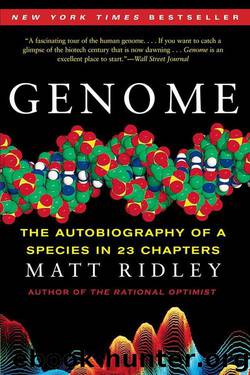Genome: The Autobiography of a Species in 23 Chapters by Matt Ridley

Author:Matt Ridley [Ridley, Matt]
Language: eng
Format: epub
Tags: History, Science, Non-Fiction
ISBN: 9780060894085
Publisher: Harper Perennial
Published: 1998-12-31T23:00:00+00:00
CHROMOSOME 13
Pre-History
Antiquitas saeculi juventus mundi (Ancient times were the youth of the world)
Francis Bacon
The surprising similarity of embryological genes in worms, flies, chicks and people sings an eloquent song of common descent. The reason we know of this similarity is because DN A is a code written in a simple alphabet - a language. We compare the vocabulary of developmental genes and find the same words. On a completely different scale, but with direct analogy, the same is true of human language: by comparing the vocabularies of human languages, we can deduce their common ancestry. Italian, French, Spanish and Romanian share word roots from Latin, for instance. These two processes — linguistic philology and genetic phylogeny — are converging upon a common theme: the history of human migrations. Historians may lament the lack of written records to document the distant, prehistoric past, but there is a written record, in the genes, and a spoken one, too, in the very vocabulary of human language. For reasons that will slowly emerge, chromosome 13 is a good place to discuss the genetics of genealogy.
In 1786 Sir William Jones, a British judge in Calcutta, announced to a meeting of the Royal Asiatic Society that his studies of the archaic Indian language Sanskrit had led him to conclude that it was a cousin of Latin and Greek. Being a learned fellow he also thought he saw similarities between these three languages and Celtic, Gothic and Persian. They had all, he suggested, ‘sprung from some common source’. His reasoning was exactly the same as the reasoning which led modern geneticists to propose the existence of the Roundish Flat Worm of 530 million years ago: similarities of vocabulary. For instance, the word for three is ‘tres’ in Latin, ‘treis’ in Greek and ‘tryas’ in Sanskrit. Of course, the great difference between spoken languages and genetic languages is that there is much more horizontal borrowing of words in spoken language. Perhaps the word for three had somehow been inserted into Sanskrit from a western tongue. But subsequent research has confirmed that Jones was absolutely right and that there was once a single people, speaking a single language in a single place and that descendants of those people brought that language to lands as far apart as Ireland and India, where it gradually diverged into modern tongues.
We can even learn something about these people. The Indo-Europeans, as they are known, expanded at least 8,000 years ago from their homeland, which some think was in the modern Ukraine, but was more likely in a hilly part of modern Turkey (the language had words for hills and fast-flowing streams). Whichever is correct, the people were undoubtedly farmers — their language also had words for crops, cows, sheep and dogs. Since this dates them to soon after the very invention of agriculture in the so-called fertile crescent of Syria and Mesopotamia, we can easily picture that their immense success in stamping their mother tongue on two continents was due to their agricultural technology.
Download
This site does not store any files on its server. We only index and link to content provided by other sites. Please contact the content providers to delete copyright contents if any and email us, we'll remove relevant links or contents immediately.
Sapiens: A Brief History of Humankind by Yuval Noah Harari(14221)
Sapiens by Yuval Noah Harari(5281)
Pale Blue Dot by Carl Sagan(4886)
Homo Deus: A Brief History of Tomorrow by Yuval Noah Harari(4801)
Livewired by David Eagleman(3663)
Origin Story: A Big History of Everything by David Christian(3632)
Brief Answers to the Big Questions by Stephen Hawking(3358)
Inferior by Angela Saini(3260)
Origin Story by David Christian(3133)
Signature in the Cell: DNA and the Evidence for Intelligent Design by Stephen C. Meyer(3056)
The Gene: An Intimate History by Siddhartha Mukherjee(3029)
The Evolution of Beauty by Richard O. Prum(2926)
Aliens by Jim Al-Khalili(2776)
How The Mind Works by Steven Pinker(2714)
A Short History of Nearly Everything by Bryson Bill(2616)
Sex at Dawn: The Prehistoric Origins of Modern Sexuality by Ryan Christopher(2472)
From Bacteria to Bach and Back by Daniel C. Dennett(2432)
Endless Forms Most Beautiful by Sean B. Carroll(2415)
Who We Are and How We Got Here by David Reich(2387)
